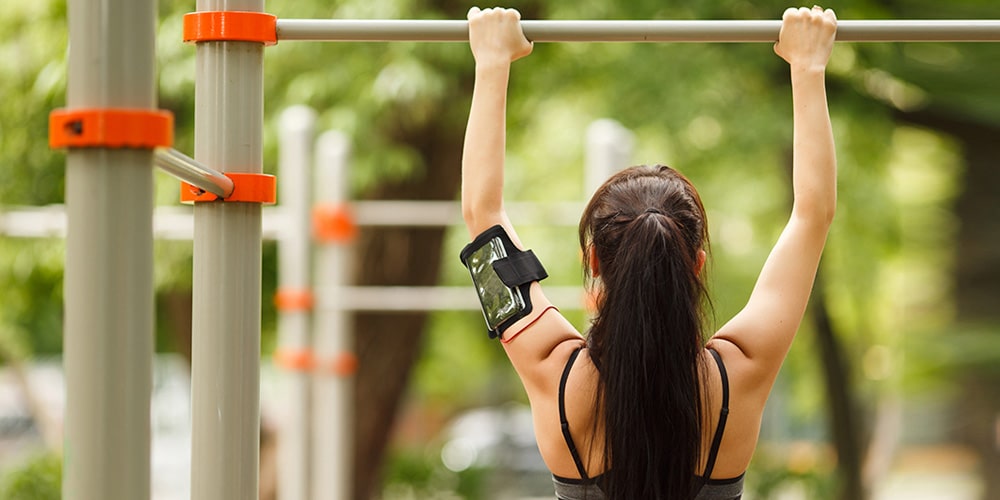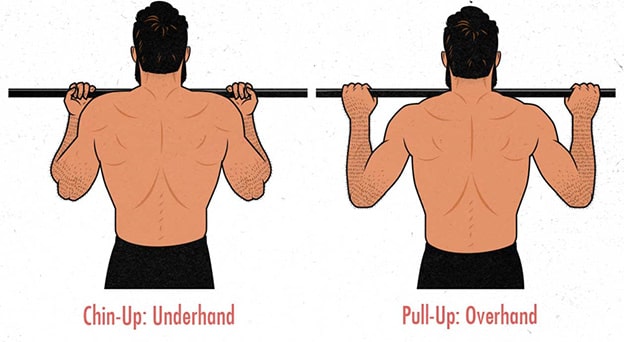
Apply These 8 Secret Techniques to Improve Your Chin Up
Tuesday, October 6, 2020
Having the strength to do a chin-up can come in handy more than you might think. Whether you're hoping to join the chin up club or your goal is to complete a Spartan race, chin-ups are one of those essential exercises.
Here, we're going through chin-up progression techniques to help you improve your upper body strength and nail your chin-ups with perfect form.
Chin Up vs Pull Up
Although they often get confused with one another, the difference between a chin-up and a pull up is all about hand placement.
Technically, a chin-up is a pull-up with your palms facing in toward you and a traditional pull-up is when your palms face out, away from you.
Both are difficult exercises and are solid markers for upper body strength. However, pull-ups are typically known to be more difficult than chin-ups. Long story short, chin-ups are a variation of pull-ups but both can help improve your upper body strength.
While working with an exercise physiotherapist to achieve the goal of doing chin-ups correctly, they'll have you on a personalised progression plan to take you from an absolute beginner to doing multiple sets of chin-ups in a row.

Image Source – Outlift
Here are some techniques your exercise physio might use to improve your chin-up game.
How to Improve Your Chin-Ups in 9 Steps
Chin-ups progression techniques are all about starting slow and working your way to the end goal, little by little. Doing too much too soon can cause you to give up altogether or worse, you might get pretty badly injured.
So, for an absolute beginner working on your chin-ups, here's an example of a 9-step chin-up progression you might work on with your exercise physiotherapist:
-
Hollow Position
Similar to a V-up, the hollow position helps strengthen your core and prepares your body to understand the correct position of a chin-up on the bar.
- Lie on your back with your arms above your head and your legs straight and crossed at the ankles.
- Keeping your lower back pressed against the floor, engage your core and lift your legs and upper body, creating a “hollow position,” almost like a V.
- Hold, release, and repeat.
Source – Tony Gentilcore
-
Roll Out with a Stability Ball
This exercise to be done with a stability ball can also be used to strengthen the core and prepare your body to do a chin-up.
- Kneel in front of a stability ball and place your wrists on top of the ball.
- Keeping your core engaged, roll the ball away from you, extending your arms out long, before rolling back into the starting position.
- Be sure not to let your back hyperextend.
Source – UI Recreational Services
-
Push-Ups
Push-ups are one of the best upper body exercises you can do to prepare for chin-ups. However, you'll want to avoid doing variations where you lower your knees. If you need to modify, do straight-leg push-ups with your hands on a bench, step, or yoga block instead.
Source – Cakisthenicmovement
-
Straight-Arm Hang
Now, you're ready to head to be chin-up bar. However, all you'll be doing is a straight-arm hang, also known as a dead hang.
- Create the hollow position with your body while hanging onto the chin-up bar using an underhand grip (palms facing towards you).
- Be sure that your shoulders are pulled down away from your ears.
- Keep your body engaged with your legs straight.
This exercise not only gets your muscles ready to do a chin-up, but it also prepares your hands for the challenge since gripping the bar can be tough in and of itself. Even if you can only hold on for a few seconds at a time, this is an important step toward improving your chin-ups.
Source – Adam McCubbin
-
Flexed-Arm Hang
Once you get used to hanging from the chin-up bar, it's time to try a flexed-arm hang. Use a stool or have your physio help you into the starting position.
- Hold onto the bar with an underhand grip with your elbows bent and your chin above the bar.
- Stay in this position for as long as you can, getting used to which muscles are activated.
This step is much more difficult than a straight-arm hang, so go slowly. It's always safer to work with a trainer or physio by the time you get to this step in your chin-up technique progression.
As you start to notice the flexed-arm hang getting easier, you can begin to gently lower yourself into a straight-arm hang versus collapsing out of the position.
Source – West Point Department of Physical Education
-
Assisted Chin-Ups
This is the part where you'll start to put everything together into one motion with an assisted chin-up.
- Place a stool or chair underneath the chin-up bar.
- Grab the bar with both hands using an underhand grip with one foot on the chair or stool.
- Practise your chin-ups using your leg to assist you.
Source – Mike Vacanti
-
Jackknife Chin-Ups
Your feet will not be on the ground, but on an elevated surface. Find a bar to grip (higher than your feet) and pull, bringing your chin above the bar.
Source – Cody Boom Boom McBroom
-
Eccentric Chin-Ups
Without any assistance, use momentum to do eccentric chin-ups. Jump into the flexed chin-up position where your chin is over the bar and slowly lower back down.
Source – Glute Lab
You're Ready for Chin-Ups
Now, all that's left to do is a set of regular chin-ups from a dead hang to the full expression of the exercise with your chin over the bar. After completing each step of the chin-up progression, doing a full chin-up should be a whole lot easier than when you were first starting out.
Other Exercises to Improve Your Chin-Ups
The truth is, most upper body exercises will help your chin-up. Lat pulldowns, rows, and bicep curls will all be super beneficial if your ultimate goal is achieving a chin-up with correct form.
Need help with your chin-up technique? Reach out to one of our Exercise Physiologists. We'll work with you on a personalised upper body workout program to help you achieve your fitness goals.
Call us today to book an appointment at one of our many Australia locations today or we'll come to you. Whether you're training for an important fitness test or you simply want to show off some new chin-up skills, our Exercise Physiologists can help.
This article was originally written by Jonathan Moody from Physio Inq

